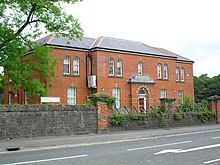William Frederick Wakeman

William Frederick Wakeman (1822 – 15 October 1900) was an Irish archaeologist, initially producing works as an artist and then as an author.
Life
W. F. Wakeman was born in Dublin, 1822. His father was a publisher. A student of George Petrie, Wakeman produced pen and pencil sketches of land features and antiquities while employed as a draughtsman by the Ordnance Survey of Ireland. The works of this period are held by the Royal Irish Academy.[1]

After the closing of the topographical department of the Survey, he took teaching roles at St. Columba's College in County Meath[1] and the Portora Royal and District National Model schools in Enniskillen, County Fermanagh.[2] He eventually abandoned art to pursue his interest in archaeology.[1]
Wakeman died on 15 October 1900, in Coleraine, County Londonderry.[1]
Works
Wakeman's works include:[1]
- Archaeologica Hibernica: A Hand-book of Irish Antiquities (1848).[3] A third edition was produced in 1903 by John Cooke[4]
- Three Days on the Shannon
- Guide to Lough Erne, or Lough Erne, Enniskillen, Belleek, Ballyshannon and Bundoran, with routes from Dublin to Enniskillen and Bundoran, by rail or steamboat[2]
- Guide to Dublin
- Account on the Island of Inishmurray
- Articles and correspondence in archaeological journals and the Dublin Evening Telegraph
As illustrator only:
- Parishes of Ballysodare and Kilvarnet, Archdeacon O'Rorke
- Irish Lake Dwellings, Colonel Wood Martin
- St. Patrick's Purgatory, Lough Derg (1903), D. Canon O'Connor
References
- ^ a b c d e "William Frederick Wakeman". Changing Libraries Initiative – reading-room. An Chomhairle Leabharlanna. Retrieved 11 October 2010.
- ^ a b Wakeman, W. F. (1870). Lough Erne, Enniskillen, Belleek, Ballyshannon, and Bundoran: with Routes from Dublin to Enniskillen and Bundoran, by Rail or Steamboat. Dublin: John Mullany. Title page. Retrieved 14 June 2013.
- ^ Wakeman, William F. (1848). Archaeologia Hibernica: A Hand-book of Irish Antiquities. Transcript. Retrieved 14 June 2013.
- ^ Cooke, John, ed. (1903). Wakeman's Handbook of Irish Antiquities (3rd ed.). Dublin: Hodges, Figgis & Co. pp. iii–viii. Retrieved 14 June 2013.
